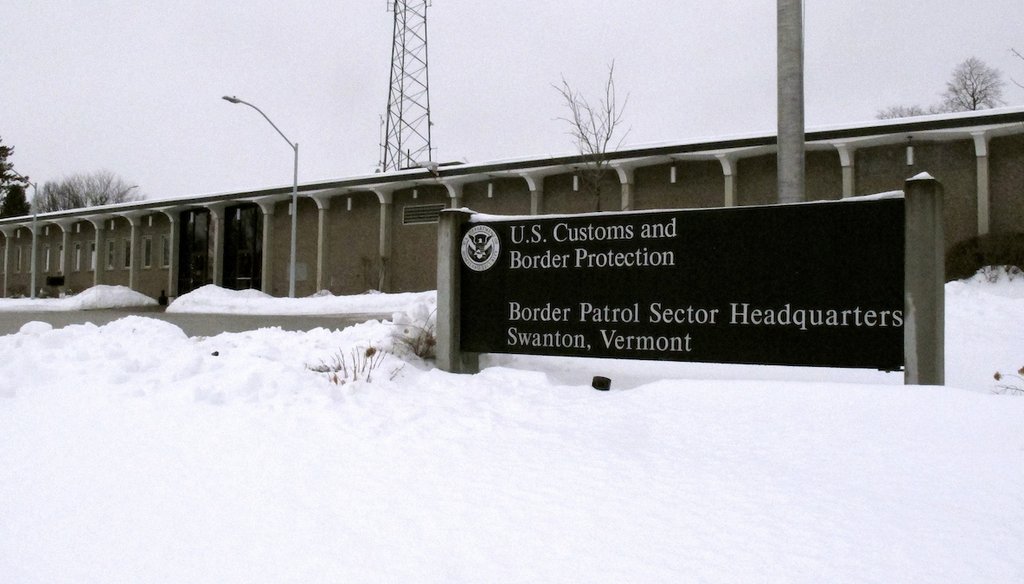



The headquarters of the U.S. Border Patrol's Swanton Sector in Swanton, Vt., on Feb. 10, 2020. (AP)
The northern border has seen increases in illegal crossings of varying amounts, depending upon the time periods that are compared.
One comparison, highlighted by U.S. Customs and Border Protection, shows that there was an 846% increase when a four-month period was compared, year-over-year.
Learn more about PolitiFact's fact-checking process and rating system.
Migrants crossing into the United States from the southern border get many headlines, but there has also been an increase in crossings at the U.S.-Canada border.
Rep. Elise Stefanik, R-N.Y., who represents a geographically large district in the North Country and Adirondack Park, said on Fox News that the number of illegal crossings is many times higher than it has been in the past.
"We’ve seen an 800% increase in the Swanton sector, which is the part of the northern border that I represent, in illegal crossings," Stefanik said Jan 28 on "Sunday Morning Futures with Maria Bartiromo."
We wondered if there has been an increase of 800% in illegal crossings.
The Swanton sector includes an estimated 24,000 square miles and includes northeastern counties in New York, three counties in New Hampshire and all of Vermont. It is responsible for 295 miles of the U.S.-Canada border, over land and water.
Year-over-year increases in illegal crossings have been steady since the fiscal year that began Oct. 1, 2020, rising from just 365 that year to 1,065 in the next fiscal year, which ended in September 2022. In fiscal year 2023, the number of people encountered at the border jumped to 6,925, representing the largest year-over-year increase so far. However, if current trends continue, 2024 will outpace the jump in 2023. In the first three months of fiscal year 2024, there have been 2,607 crossings, compared with 1,147 during the same period last year.
Within this data, there are different time periods in which to calculate the increase, all yielding different results.
Stefanik could have seen a U.S. Customs and Border Protection news release from February 2023, which stated that there had been an approximate 846% increase in encounters and apprehensions between Oct. 1, 2022, and Jan. 31, 2023, compared with the same period in fiscal year 2022.
In November, U.S. Customs and Border Protection Chief Patrol Agent Robert N. Garcia of the Swanton sector posted on X that there had been a 550% increase in apprehensions between fiscal year 2022 and 2023, and that the migrants came from 79 countries. Garcia posted in August that apprehensions in just over 10 months exceeded the previous nine years combined.
Experts we spoke with found that the increases, while large for the northern border, are small when compared to other places on the northern border, or the southern border, which has many more crossings.
"Percentages can look really big, but the numbers themselves can be quite small," said Colleen Putzel-Kavanaugh, an associate policy analyst at the Migration Policy Institute, a nonpartisan think tank.
U.S. Customs and Border Protection’s Buffalo Field Office, which operates ports of entry in Erie and Niagara counties, has many more encounters, 84,429 in fiscal year 2023, or 12 times more than the Swanton sector. "Encounters" are people seeking admission who are not authorized to do so.
Along the entire southern border during 2023, there were more than 6,700 encounters per day on average, or 2.48 million total.
Immigration experts caution that the number of encounters at a border is not the same thing as the number of people who tried to cross, because the same person could try to cross more than once. But Stefanik said crossings, not people.
Are these illegal crossings? Any crossing of the border without prior authorization is an illegal entry, but people have a right to ask for asylum, saying they have a fear of returning to their home country, Putzel-Kavanaugh said. These asylum seekers are released with a charge that they entered illegally. When they ask for asylum, they can defend their charge with the reasons why they are seeking asylum.
Experts attributed the higher migration at the U.S.-Canada border with an increase in migration around the world, Canada’s decision in 2016 to permit Mexicans to fly there without stringent visa requirements, and a subsequent southern movement of these migrants.
Last spring, the U.S. Department of Homeland Security requested that Canada reimpose the visa restrictions, but Canada has not done that, said Aaron Reichlin-Melnick, policy director at the American Immigration Council, a pro-immigration advocacy organization.
Data from the Swanton sector show that the top two countries of origin for migrants crossing there are Mexico and India.
Stefanik’s office did not return a request for comment.
Stefanik claimed that there has been at some point an 800% increase in illegal crossings in the Swanton sector of the U.S.-Canada border.
Stefanik did not say which time period she was talking about. The increases in unauthorized crossings vary depending on the time period, but there have been increases exceeding 800% at the border. The actual numbers of encounters remain very low compared with crossings at the southern border.
The crossings are illegal, but people seeking asylum can use their status as an asylum seeker as a defense for crossing illegally.
We rate Stefanik’s claim True.
U.S. Customs and Border Protection Encounters in the Swanton Sector as of Jan. 4, 2024.
Fox Business, "Sunday Morning Futures" video, Jan. 28, 2024.
Phone interview, Colleen Putzel-Kavanaugh, associate policy analyst, Migration Policy Institute, Feb. 7, 2024.
Email interview, Aaron Reichlin-Melnick, policy director at the American Immigration Council, Feb. 12, 2024.
U.S. Border Patrol Swanton Sector Chief Patrol Agent Robert Garcia, X post, Nov. 21, 2023, and X post, Aug. 7, 2023.
In a world of wild talk and fake news, help us stand up for the facts.
